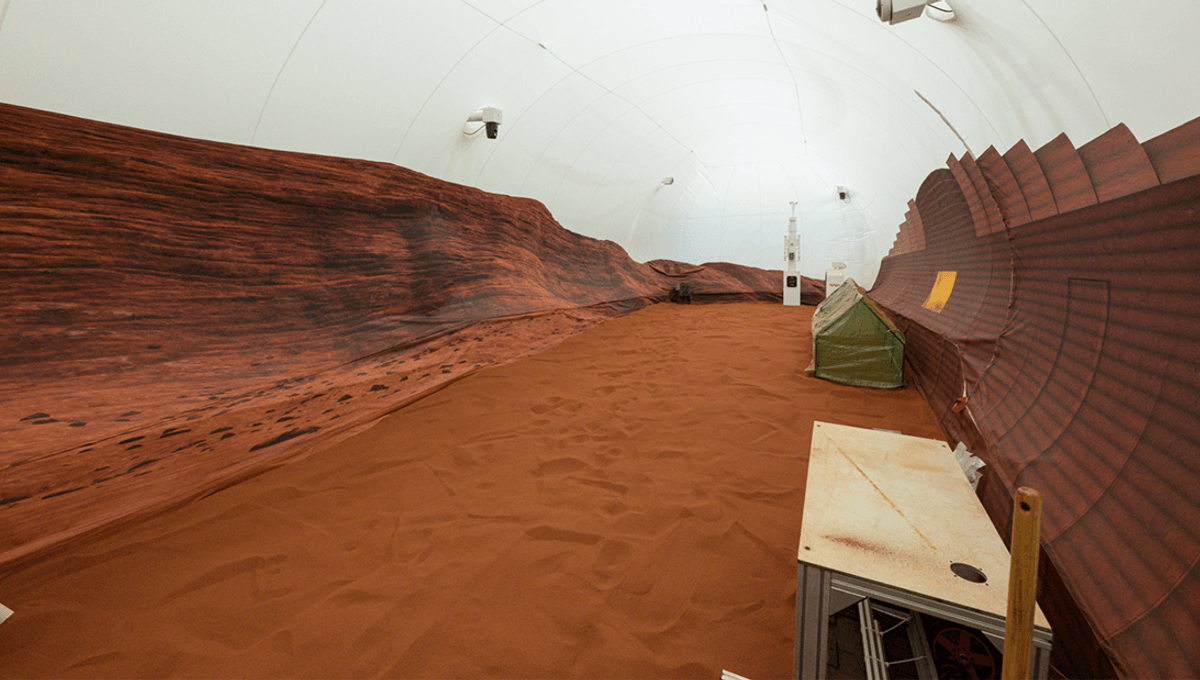
Four volunteers will soon be sealed inside an imitation Mars habitat on Earth, simulating a year-long mission to the Red Planet ahead of the real deal.
On October 19, the volunteers will step foot inside their new home and not emerge until Halloween 2026, 378 days later. The study is the second of three planned simulations of living on the surface of Mars, part of NASA’s Crew Health and Performance Exploration Analog (CHAPEA) mission.
The crew – which this year includes a pilot and a hardware engineering design consultant – will take on astronaut roles of flight engineer, medical officer, science officer, and commander while they stay in their 3D-printed, 158-square-meter (1,700-square-foot) Mars Dune Alpha habitat.
As well as the psychological strain of being away from loved ones for a year, the crew will face other challenges set by the researchers overseeing them. CHAPEA will simulate conditions that crews of a Mars mission would face, including limited resources and communication delays lasting between 5 and 20 minutes. They will also face simulated equipment failures, simulated high-tempo extravehicular activities, and very much not simulated isolation and confinement.
“As NASA gears up for crewed Artemis missions, CHAPEA and other ground analogs are helping to determine which capabilities could best support future crews in overcoming the human health and performance challenges of living and operating beyond Earth’s resources,” Sara Whiting, project scientist with NASA’s Human Research Program at NASA Johnson, explained in a statement, “all before we send humans to Mars.”
During their stay, the crew will also conduct activities such as simulating walks outside the habitat on Mars, and other scientific research. This will include growing a vegetable garden (hopefully not Mark Watney style) and overseeing robotic operations in the simulated Martian environment. They will also test a number of new technologies specifically designed for astronauts heading to Mars, including diagnostic medical equipment and a potable water dispenser.
“The simulation will allow us to collect cognitive and physical performance data to give us more insight into the potential impacts of the resource restrictions and long-duration missions to Mars on crew health and performance,” Grace Douglas, CHAPEA principal investigator, added. “Ultimately, this information will help NASA make informed decisions to design and plan for a successful human mission to Mars.”
Previous efforts have been made to simulate long-term living on another planet, with mixed results. Simulations run by Scientific International Research In Unique Terrestrial Station (Project SIRIUS) and Mars-500 found that the crews began to live more autonomously as communication delays increased. Though positive in the sense that any Mars crew would need to perform duties alone, there were worries of possible disconnects between astronauts on the surface and mission control back on Earth.
“The negative side is that the mission control loses the possibility to understand the needs and problems of the crew,” Dmitry Shved of the Russian Academy of Sciences and the Moscow Aviation Institute told CNET, “which consequently hinders mission control’s ability to provide support.”
The crew of the first CHAPEA mission, which concluded in July 2024, were able to cope with the isolation that such a mission brings.
“We had to rely on each other and our training to navigate the challenges we faced,” Mission Commander Kelly Haston said in a statement.
During the mission, communications were limited to simulate the time it takes to send information from Mars, as well as the limited bandwidth available.
“Even something as simple as when to communicate is important,” Medical Officer Nathan Jones added. “Everything we do in CHAPEA is touched by the heroes working on the ground at NASA. We couldn’t ask for a better experience or better people to work with.”
Let’s hope the new crew’s mission is as successful as the first.
Source Link: NASA Is Set To Lock Up Four Volunteers For 378-Day Mars Simulation Study